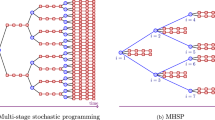Abstract
This paper considers the constrained redundancy optimization problem in series systems. This problem can be formulated as a nonlinear integer programming problem of maximizing the overall systems reliability under limited resource constraints. By exploiting special features of the problem, we derive a new necessary condition for optimal redundancy assignments. This condition leads to a new fathoming condition in the branch and bound method that may result in a significant reduction of computational efforts, as evidenced in our numerical calculation for linearly constrained redundancy optimization problems.
Similar content being viewed by others
References
R. Bellman and S. Dreyfus, “Dynamic programming and the reliability of multicomponent devices,” Opns. Res.vol.6, pp. 200–206, 1958.
A. Birolini, Reliability Engineering: Theory and Practice, Springer: New York, 1999.
M. S. Chern, “On the computational complexity of reliability redundancy allocation in a series system,” Opns.Res. Lett. vol. 11, pp. 309–315, 1992.
B. Fox, “Discrete optimization via marginal analysis,” Mgmt. Sci. vol. 13, pp. 210–216, 1966.
P. M. Ghare and R. E. Taylor, “Optimal redundancy for reliability in series systems,” Oper. Res. vol. 17, pp. 838–847, 1969.
O. K. Gupta and A. Ravindran, “Branch and bound experiments in convex nonlinear integer programming,” Management Sci. vol. 31, pp. 1533–1546, 1985.
D. Li and Y. Y. Haimes, “A decomposition method for optimization of large system reliability,” IEEE Trans.Reliability vol. 41, pp. 183–189, 1992.
K. B. Misra and U. Sharma, “An efficient algorithm to solve integer-programming problems arising in systemreliability design,” IEEE Trans. Reliability vol. 40, pp. 81–91, 1991.
Y. Nakagawa, K. Nakashima, and Y. Hattori, “Optimal reliability allocation by branch-and-bound technique,” IEEE Trans. Reliability vol. R-27, pp. 31–38, 1978.
H. Ohtagaki, Y. Nakagawa, A. Iwasaki, and H. Narihisa, “Smart greedy procedure for solving a nonlinear knapsack class of reliability optimization problems,” Mathl. Comput. Modelling vol. 22, pp. 261–272, 1995.
J. G. Shanthikumar and D. D. Yao, “On server allocation in multiple center manufacturing systems,” Opns. Res.vol.36, pp. 333–341, 1988.
C. Sundararajan, Guide to Reliability Engineering: Data, Analysis, Applications, Implementation, and Management, Van Nostrand Reinhold: New York, 1991.
F. A. Tillman, C. L. Hwuang, and W. Kuo, “Optimization techniques for system reliability with redundancy: A Review,” IEEE Trans. Reliability vol. 26, pp. 148–155, 1977.
F. A. Tillman, C. L. Hwuang, and W. Kuo, Optimization of System Reliability, Marcel Dekker, 1980.
S. G. Tzafestas, “Optimization of system reliability: A survey of problems and techniques,” International Journal of Systems Science vol. 11, pp. 455–486, 1980.
Author information
Authors and Affiliations
Rights and permissions
About this article
Cite this article
Sun, X.L., Li, D. Optimality Condition and Branch and Bound Algorithm for Constrained Redundancy Optimization in Series Systems. Optimization and Engineering 3, 53–65 (2002). https://doi.org/10.1023/A:1016541912439
Issue Date:
DOI: https://doi.org/10.1023/A:1016541912439




